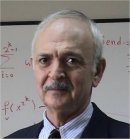|
Keynote
Lecture
Nonlinear Explicit Ordinary Differential Equations:
Are They Really Nonlinear?

Professor Metin Demiralp
Informatics Institute
Istanbul Technical University
TURKEY
E-mail:
metin.demiralp@be.itu.edu.tr
Abstract: We (myself, my son, my colleagues in my
group and some other collaborators from certain
universities) were concerning with construction of a
fictituos probabilistic dynamics behind the ordinary
differential equations. This was based on the fact that
some dynamical systems like quantum dynamics or
Liouville dynamics are governed by partial differential
equations. However, it is also possible to construct an
infinite degree of freedom system over the expectations
or expected values of some operators such that these
expectations are connected through some ordinary
differential equations in infinite number since the
operators appearing in the expectations are related to
each other recursively through commutators without
stopping. At the beginning even these expectation ODEs
could have nonlinearities. After intense studies in our
group we could be able to show that these ODEs can be
structured in linear format by using certain appropriate
basis operators. What we have observed was the fact that
the lower number of ODEs were resulting in mostly
nonlinear structures unless very specific characters are
existing in the system under consideration. However
infinite number of equations were capable of bringing
linearity. This was a one way research. From
probabilistic equations to ODEs. Later we focused on the
reverse action. To find an appropriate probabilistic
structure like partial differential equation became the
target of our efforts. Four years ago, my son Emre
Demiralp, joined with a group in University Michigan at
Ann Arbor to work on neuroscientific problems. By his
pushes on me we started to deal with the mathematical
structure behind the brain activities. Since these
problems were having too many parameters and
necessitating huge number of data, the models might need
causal and probabilistic aspects. However all systems
were at most considered as dynamical systems which are
governed by ODEs. If there would be a probabilistic
structure it would be behind these mathematical objects.
Our efforts intensified and focused on this issue. The
last year our project group took some important steps
and possibility of birth of a quantum mechanical
background system seemed to be appearing on the horizon.
This encouraged us to continue and eventually we could
be able to develop a probabilistic structure not like
quantum or Liouville mechanics but something new. There
appeared an evolution operator instead of the
Hamiltonian. A first order partial differential equation
could have been constructed. Its solution was possessing
wave function properties and so on. When this is done
what we have seen was an infinite linear ordinary
differential equation set with constant coefficient
matrix. This was valid for all explicit ODEs, linear or
nonlinear. Then we focused on to reveal this feature
without using probabilistic toolsand considerations.
Today we are at point that all these are accomplished.
There is no nonlinear explicit ODEs but the nonlinear
representation of infinitely linear structures. In other
words, nonlinearity is the folded form of linearity.
Many of well known ODEs are now under the attack of our
group. Our major studies are directed to this area.
Brief Biography of the Speaker:
Metin Demiralp was born in Turkey on 4 May 1948. His
education from elementary school to university was
entirely in Turkey. He got his BS, MS, and PhD from the
same institution, Istanbul Technical University. He was
originally chemical engineer, however, through
theoretical chemistry, applied mathematics, and
computational science years he was mostly working on
methodology for computational sciences and he is
continuing to do so. He has a group (Group for Science
and Methods of Computing) in Informatics Institute of
Istanbul Technical University (he is the founder of this
institute). He collaborated with the Prof. Herschel A.
Rabitz’s group at Princeton University (NJ, USA) at
summer and winter semester breaks during the period
1985–2003 after his 14 months long postdoctoral visit to
the same group in 1979–1980. Metin Demiralp has more
than 90 papers in well known and prestigious scientific
journals, and, more than 170 contributions to the
proceedings of various international conferences. He
gave many invited talks in various prestigious
scientific meetings and academic institutions. He has a
good scientific reputation in his country and he is one
of the principal members of Turkish Academy of Sciences
since 1994. He is also a member of European Mathematical
Society and the chief–editor of WSEAS Transactions on
Computers currently. He has also two important awards of
turkish scientific establishments. The important recent
foci in research areas of Metin Demiralp can be roughly
listed as follows: Fluctuation Free Matrix
Representations, High Dimensional Model Representations,
Space Extension Methods, Data Processing via
Multivariate Analytical Tools, Multivariate Numerical
Integration via New Efficient Approaches, Matrix
Decompositions, Multiway Array Decompositions, Enhanced
Multivariate Product Representations, Quantum Optimal
Control.
|
